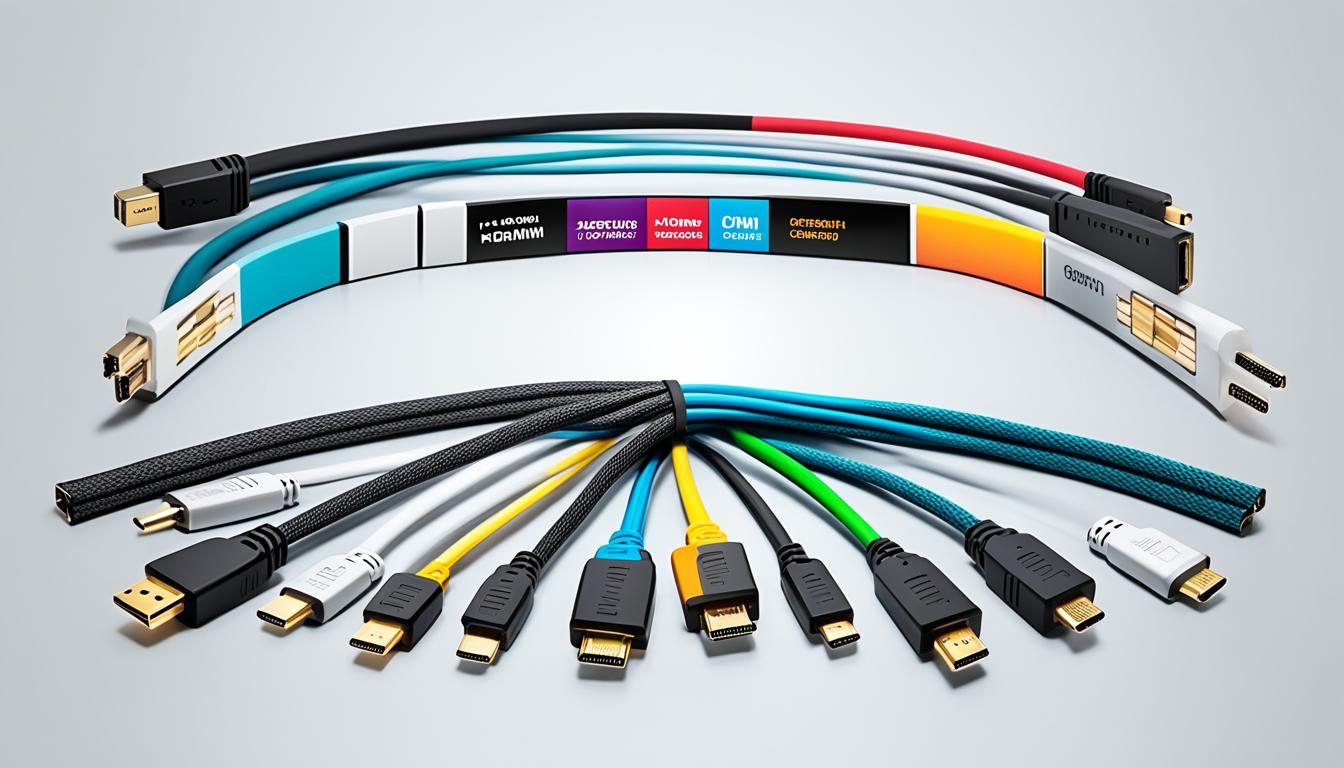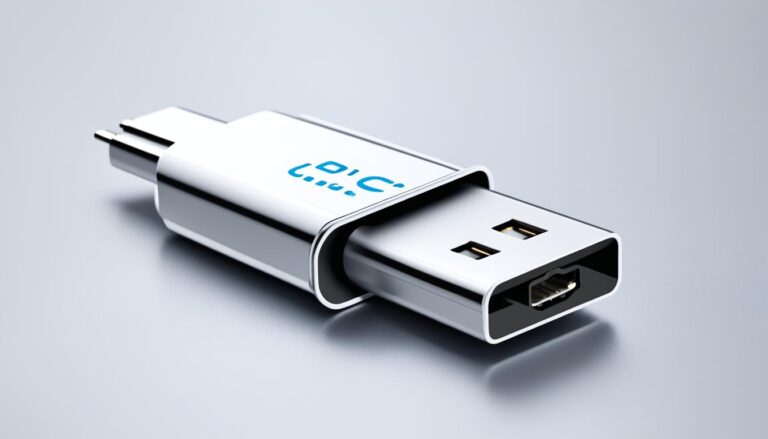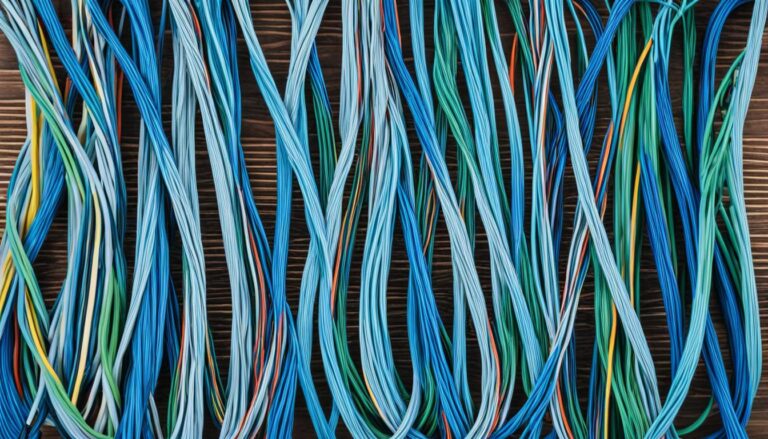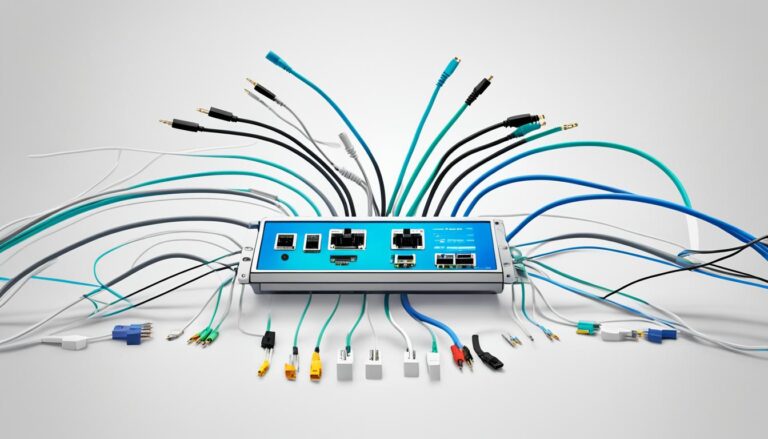HDMI cables are vital for boosting your viewing experience. They let you link audio/video parts to your monitor. This enhances both picture and sound quality. It’s key to know the different types of HDMI cables to choose the right one for your needs.
Having the correct info helps you make a smart choice. This choice will better your visual experience. In this article, we delve into various HDMI cable types. We also discuss what factors you should look at, how they match with your monitors, and why the length of the cable matters. By the conclusion, you’ll know just how to pinpoint the best HDMI cable for you.
Understanding HDMI Cables and Key Features
HDMI cables let you send digital video and audio from one device to another. They give us clear video and good sound, making the experience better. Knowing what makes each HDMI cable different is key before you choose one.
The Key Features of HDMI Cables
There are several features to think about when picking an HDMI cable:
- Maximum Transmission Bit Rate: HDMI cables vary in how much data they can handle. More data means better sound and picture. Make sure the cable matches your need for high-quality content.
- Color Depth: This is about how many colors the cable can show. More colors mean better, lifelike images. Pick a cable that makes your visuals pop.
- Compatibility with A/V Components: Check if the HDMI cable works with your devices like Blu-ray players or TVs. It should support the video and audio types you use.
Knowing these features gets you closer to the perfect HDMI cable. Think about what you want in terms of picture and sound. Then, pick a cable that fits those desires. This way, you’ll get the most from your setup and enjoy awesome videos and audio.
Why Key Features Matter
Understanding the special features of HDMI cables is crucial for the best experience. These elements affect signal quality and how well devices connect. They ensure your setup works brilliantly.
Take your time to consider bit rate, color depth, and compatibility. The right HDMI cable will make your movies and games look and sound fantastic. It’s worth investing in a cable that suits your system.
| Key Feature | Description |
|---|---|
| Maximum Transmission Bit Rate | The max data sent every second. Higher rates mean better video and sound. |
| Color Depth | Shows how many colors can be displayed. More depth equals more vivid colors. |
| Compatibility with A/V Components | Ensures the HDMI cable fits well with your audio and video devices, catering to various formats. |
Different Types of HDMI Cables
There are four main HDMI cable types, each with different features. They vary by maximum transmission bit rate and color depth. This helps meet various needs.
- Standard HDMI Cable: Ideal for basic use, this cable supports up to 4.95 Gbps transmission. It allows up to 8 bits per color channel.
- High-Speed HDMI Cable: This is the most common choice. It can go up to 18 Gbps and supports up to 48 bits per color. It’s great for 1080p and 4K Ultra HD video and audio.
- Premium High-Speed HDMI Cable: Designed for top-notch formats, it reaches up to 48 Gbps. It’s perfect for 8K resolution and rich audio. Plus, it enhances refresh rates and delivers dynamic HDR for a deeper experience.
- Ultra High-Speed HDMI Cable: The latest and most powerful, it also hits 48 Gbps. Tailored for 8K, gaming, and VR, it meets the needs of ultra-high-definition audio and video.
Choosing the correct HDMI cable matters. It ensures your system works at its best. The right choice supports your equipment and lets you enjoy your displays fully.
Choosing the Right HDMI Cable
When picking an HDMI cable, think about what you need for the best performance. Keep these important points in mind:
1. Connector Type
HDMI cables come with Type A (standard) or Type C (mini) connectors. Type A connects to TVs, game consoles, and Blu-ray players. Type C is for portable devices like cameras. Make sure the connector fits your device.
2. Resolutions Supported
Resolutions are key. HDMI cables handle different video qualities, from HD to 4K. Match the cable with your display and source device’s resolution. This ensures a clear picture.
3. Distance and Cable Length
Length matters for signal quality. Long HDMI cables might lose video quality. 50 feet is ok for 1080p, and 25-30 feet for 4K. For more distance, consider a signal booster or HDMI over Ethernet extenders. Choose a cable that suits your space without losing quality.
4. Special Uses and Features
Some HDMI cables have extra features. They can offer internet connectivity alongside video/audio. Some have gold-plated connectors to improve signal and reduce interference. Think about what extra features you might need.
“Choosing the right HDMI cable matters for a great audiovisual experience. Think about connector type, resolution, distance, and special features to get the best from your HDMI setup.”
Pick the right HDMI cable to meet your needs for a strong and quality connection. Consider what you need and choose wisely to boost your experience.
Understanding HDMI Versions and Compatibility
HDMI has grown with technology, bringing out new versions. Yet, version numbers don’t promise full feature compatibility.
When picking components, don’t just look at the HDMI version. Think about the transmission rate, color depth, and resolution. These factors help you figure out if a component meets your needs.
Old devices with HDMI can work with new versions but might lack some features. They can send audio and video. But they might not have the latest upgrades.
If you want the newest HDMI benefits, consider upgrading your devices. This way, you can enjoy high resolution and rich colors among other new features.
Knowing about HDMI versions and compatibility helps you choose the right cables and parts for your setup. Always think about what you need and want for the best performance and compatibility.
HDMI Cable Length and Considerations
HDMI cables are essential for connecting your devices to a monitor. It’s important to think about the cable length. Long cables can lead to signal loss.
Signal loss with HDMI can happen over long distances. The cable’s length without a booster depends on a few things. These include cable and component quality, and the video resolution you want.
Normally, HDMI cables can send 1080p video up to 50 feet. For 4K video, the limit is about 25-30 feet.
Yet, you may go beyond these limits with good cables and the right setup.
Choosing the right HDMI cable is key. Make sure it supports HDCP to avoid quality loss or lower resolution. HDCP keeps your signal safe and high-quality.
To go further than the recommended lengths, consider a signal booster. They amplify the HDMI signal for longer travels without losing quality.
Think about your setup before buying. Measure the distance between your devices and display to pick the right HDMI cable length. This ensures the best audio and video quality.
Factors Affecting HDMI Cable Length and Signal Quality
- Cable quality: High-quality HDMI cables can better maintain signal integrity over longer distances.
- Component quality: The quality of your audio/video components can impact signal transmission.
- Desired video resolutions: Higher resolutions, such as 4K, may have more limited distance capabilities.
- Signal boosters: Using a signal booster can overcome distance limitations and maintain signal quality.
| Desired Video Resolution | Maximum Length |
|---|---|
| 1080p | Up to 50 feet |
| 4K | Approximately 25-30 feet |
Conclusion
Choosing the right HDMI cable is key for the best display. Understanding the various HDMI cables is crucial. Look into their features, and check if they match your setup. Also, think about how long the cable needs to be. This helps you make a good choice and boost your display’s quality.
Consider what your monitor needs in terms of display. Think about the resolutions you want and how you’ll set it up. Picking the right cable means meeting your needs. It ensures you get clear video and sound without hassle.
Getting the right HDMI cable boosts your viewing and listening experience. The perfect cable brings your screen to life with vivid visuals and rich sound. Enjoy amazing quality on your monitors with the right choice.
FAQ
What are the different types of HDMI cables?
HDMI cables vary based on bit rate and color depth.
How do I choose the right HDMI cable for my monitors?
To pick the right HDMI cable, think about connector types, resolutions, and how far it needs to reach. Special requirements matter too.
Do HDMI versions guarantee full feature compatibility?
HDMI version numbers don’t ensure compatibility. Always check a component’s specific abilities rather than just the version.
Can HDMI cables experience signal degradation over long distances?
Yes, over long distances, HDMI cables might lose signal quality. The length limit without a signal booster depends on the cable and component quality, and the video resolution you want.
What is High-Bandwidth Digital Content Protection (HDCP)?
HDCP stops illegal copying of copyrighted material. Make sure your HDMI cable supports HDCP to avoid losing signal quality or resolution.


















